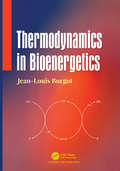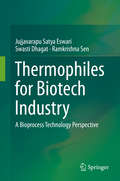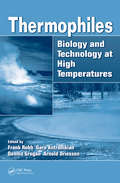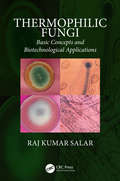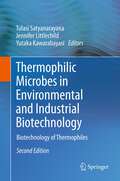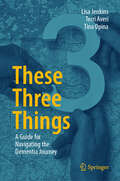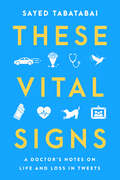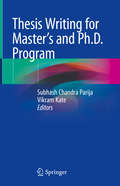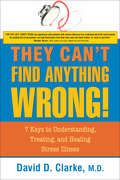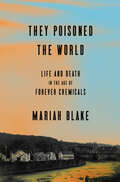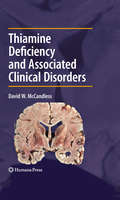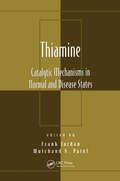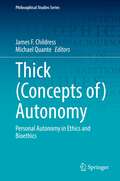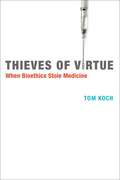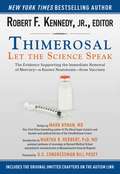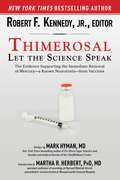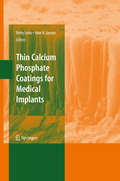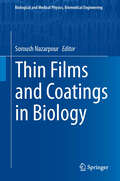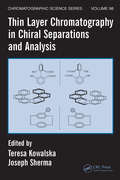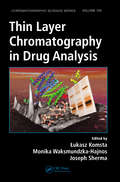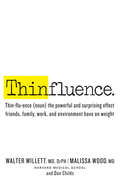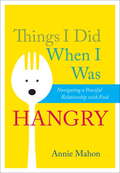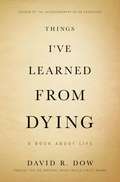- Table View
- List View
Thermodynamics in Bioenergetics
by Jean-Louis BurgotThermodynamics in Bioenergetics aims to supply students with the knowledge and understanding of the critical concepts and theories that are needed in the biochemistry and bioenergetics fields. Biochemical reactions highlighting thermodynamics, chemical kinetics, and enzymes are addressed in the text. Author, Jean-Louis Burgot, guides the reader through the starting points, strategy description, and theory results to facilitate their comprehension of the theories and examples being discussed in the book. Also discussed in the text are the notions of Gibbs energy, entropy, and exergonic and endergonic reactions.
Thermogenic Fat: Methods and Protocols (Methods in Molecular Biology #2662)
by Irfan J. LodhiThis volume presents a broad collection of state-of-the-art methods to study the biology of thermogenic fat using in vitro cell culture and animal models. Chapters guide the readers through protocols on differentiation of human pluripotent stem cells and murine adipocyte precursors; methods for measuring mitochondrial respiration, heat generation, brown fat activation, and effects on energy metabolism in mice; and techniques for AAV-mediated gene delivery, transplantation of adipose tissue, isolation of adipose tissue immune cells and extracellular vesicles, and mass spectrometry-based profiling of brown fat lipids. Written in the format of the highly successful Methods in Molecular Biology series, each chapter includes an introduction to the topic, lists necessary materials and methods, includes tips on troubleshooting and known pitfalls, and step-by-step, readily reproducible protocols. Authoritative and cutting-edge, Thermogenic Fat: Methods and Protocols aims to be comprehensive guide for researchers in the field.
Thermophiles for Biotech Industry: A Bioprocess Technology Perspective
by Swasti Dhagat Jujjavarapu Satya Eswari Ramkrishna SenThermophiles and hyperthermophiles exhibit great biotechnological potential, as they can be utilized in processes which require higher temperatures. This book comprehensively deals with all the aspects of thermophiles, starting from the source of these organisms to their latest applications. In addition it presents a compilation of all compounds produced by various thermophilic microorganisms. Due to their application in everyday life, the demands of enzymes that can work at higher temperature have been increasing. In order to keep pace with the increasing demand the industries have to search novel thermophiles producing their product of interest. Hence, this book will be of value for industries working on various biochemical products produced by these thermophiles as well as for scientists and research scholars working on microbiology and products derived from microorganisms.
Thermophiles: Biology and Technology at High Temperatures
by Frank Robb Garabed Antranikian Dennis Grogan Arnold DriessenWe might think of them as living on the very edge of existence. Referred to as extremophiles, these microorganisms exhibit the most radical capacity for adaptation in those harsh environments that are just barely conducive to the existence of cellular life. Unlocking the mechanisms and understanding the evolutionary development that allows these si
Thermophilic Fungi: Basic Concepts and Biotechnological Applications
by Raj SalarThis book aims to fill the gap by documenting thermophilic fungi discovered over the past five decades. The chapters spans from covering basic aspects, taxonomy and classification including molecular phyologeny and biotechnological applications of thermophilic fungi.
Thermophilic Microbes in Environmental and Industrial Biotechnology
by Jennifer Littlechild Tulasi Satyanarayana Yutaka KawarabayasiThe existence of life at high temperatures is quiet fascinating. At elevated temperatures, only microorganisms are capable of growth and survival. Many thermophilic microbial genera have been isolated from man-made (washing machines, factory effluents, waste streams and acid mine effluents) and natural (volcanic areas, geothermal areas, terrestrial hot springs, submarine hydrothermal vents, geothermally heated oil reserves and oil wells, sun-heated litter and soils/sediments) thermal habitats throughout the world. Both culture-dependent and culture-independent approaches have been employed for understanding the diversity of microbes in hot environments. Interest in their diversity, ecology, and physiology has increased enormously during the past few decades as indicated by the deliberations in international conferences on extremophiles and thermophiles held every alternate year and papers published in journals such as Extremophiles. Thermophilic moulds and bacteria have been extensively studied in plant biomass bioconversion processes as sources of industrial enzymes and as gene donors. In the development of third generation biofuels such as bioethanol, thermophilic fungal and bacterial enzymes are of particular interest. The book is aimed at bringing together scattered up-to-date information on various aspects of thermophiles such as the diversity of thermophiles and viruses of thermophiles, their potential roles in pollution control and bioremediation, and composting.
These Three Things: A Guide for Navigating the Dementia Journey
by Lisa Jenkins Terri Averi Tina OpinaA dementia diagnosis can be terrifying and debilitating, but this unique book can provide caregivers—whether they are family members or professionals—with practical and simple tools to effectively address behavior and communication issues that may occur when providing care to those with dementia. These Three Things takes everyday situations (dressing, hygiene, meals, etc.) and looks at them from the perspective of a person with dementia with the goal of improving communication between patient and caregiver and minimizing undesirable behaviors. Each scenario is clearly outlined, followed by three practical action steps that a caregiver can utilize to solve the problem at hand, regardless of where the person is in their dementia journey. While caregiving can be very rewarding, it is also important that caregivers take time to check in with themselves and their needs, a chapter on caregiver stress with suggestions for self care is also included. This book can be a starting point for education on dementia, or it can be used as an intervention. Written by three experts in elder care, These Three Things gives caregivers choices that they can easily make in the moment for common issues as well as encouraging creative problem solving in all other situations not covered in the text. The authors’ approach to caregiving comes from within. Caregiving does not always have to have a high financial cost, nor does it always require large time commitments, as many of the suggestions in this book demonstrate.
These Vital Signs: A Doctor's Notes on Life and Loss in Tweets
by Sayed TabatabaiA doctor reflects on his profession and his experience with patients in this brilliant essay collection that expands on his wildly popular Twitter poems.In medicine, every patient presents with a story. “Once upon a time I was well, and then . . . ” These patient narratives are the beating heart of medicine; through stories we strive to communicate, to understand, to empathize, and perhaps find healing.These Vital Signs is a poignant series of essays—deeply personal stories—inspired by nephrologist Sayed Tabatabai’s medical experience and based on a series of poems he posted on Twitter that began going viral at the height of the Covid pandemic. Each short work is a poignant glimpse into the ever-changing field of medicine and the special relationship between patients and their doctor. In each, Tabatabai beautifully evokes the emotional tension between life and death, wellness and disease, uncertainty and hope, in a unique and unforgettable way.Exploring themes of illness, dying, grief, and joy, universal in its reach, These Vital Signs tells stories both remarkable and utterly ordinary of a doctor and the patients who have shaped him.
Thesis Writing for Master's and Ph.D. Program
by Subhash Chandra Parija Vikram KateThis book on Thesis Writing for Master’s and Ph.D. program focuses on the difficulties students encounter with regard to choosing a guide; selecting an appropriate research title considering the available resources; conducting research; and ways to overcome the hardships they face while researching, writing and preparing their dissertation for submission. Thesis writing is an essential skill that medical and other postgraduates are expected to learn during their academic career as a mandatory partial requirement in order to receive the Master’s degree. However, at the majority of medical schools, writing a thesis is largely based on self-learning, which adds to the burden on students due to the tremendous amount of time spent learning the writing skills in addition to their exhausting clinical and academic work. Due to the difficulties faced during the early grooming years and lack of adequate guidance, acquiring writing skills continues to be a daunting task for most students. This book addresses these difficulties and deficiencies and provides comprehensive guidance, from selecting the research title to publishing in a scientific journal.
They Can't Find Anything Wrong: 7 Keys to Understanding, Treating, and Healing Stress Illness
by David D. ClarkeA specialist in Stress Illness reveals how to identify and remedy this potentially serious health issue that too often goes undiagnosed. Every year, millions of people seek medical care for symptoms that diagnostic tests are unable to explain. Sent away frustrated, or thinking it&’s &“all in their heads,&” the truth is that many of these people are ill because of hidden stresses. Dr. David Clarke has done pioneering work with thousands of these patients, often sent to him as a last resort. In They Can&’t Find Anything Wrong, he offers real solutions to put a stop to the stress illness epidemic. Dr. Clarke describes the major types of stress and explains steps for treatment with a range of effective techniques. Case histories that read like medical mysteries illustrate the concepts and make them easy to apply.
They Poisoned the World: Life and Death in the Age of Forever Chemicals
by Mariah BlakeA landmark investigation of the chemical industry's decades-long campaign to hide the dangers of forever chemicals, told through the story of a small town on the frontlines of an epic public health crisisIn 2014, after losing several friends and relatives to cancer, an unassuming insurance underwriter in Hoosick Falls, New York, began to suspect that the local water supply was polluted. When he tested his tap water, he discovered dangerous levels of forever chemicals. This set off a chain of events that led to 100 million Americans learning their drinking water was tainted. Although the discovery came as a shock to most, the U.S. government and the manufacturers of these toxic chemicals—used in everything from lipstick and cookware to children&’s clothing—had known about their hazards for decades.In They Poisoned the World, investigative journalist Mariah Blake tells the astonishing story of this cover-up, tracing its roots back to the Manhattan Project and through the postwar years, as industry scientists discovered that these chemicals refused to break down and were saturating the blood of virtually every human being. By the 1980s, manufacturers were secretly testing their workers and finding links to birth defects, cancer, and other serious diseases. At every step, the industry&’s deceptions were aided by our government&’s appallingly lax regulatory system—a system that has made us all guinea pigs in a vast, uncontrolled chemistry experiment.Drawing on years of on-the-ground reporting and tens of thousands of documents, Blake interweaves the secret history of forever chemicals with the moving story of how a lone village took on the chemical giants—and won. From the beloved local doctor to the young mother who took her fight all the way to the nation&’s capital, citizen activists in Hoosick Falls and beyond have ignited the most powerful grassroots environmental movement since Silent Spring.Humane and revelatory, this book will provoke outrage—and hopefully inspire the change we need to protect the health of every American for generations to come.
Thiamine Deficiency and Associated Clinical Disorders
by David W. MccandlessThiamine deficiency and related clinical disorders represent an intriguing area of both basic and clinical investigation. Modern imaging strategies have facilitated the rapid treatment, and potential reversal of these clinical disorders. The fusion of laboratory and clinical knowledge serve as an example of how research can translate to successful treatment. The goal of Thiamine Deficiency and Related Clinical Disorders is to bring together cogent results from basic and clinical investigation and to stimulate further investigations in these areas. This data will be useful to neurologists, internists, nutritionists, biochemists, neurochemists, neuroscientists, and others with interest in thiamine deficiency.
Thiamine: Catalytic Mechanisms in Normal and Disease States (Oxidative Stress and Disease)
by Mulchand S. Patel Frank JordanCompiling landmark research from those laying the foundation for medical science's next leap forward, Thiamine: Catalytic Mechanisms in Normal and Disease States fully explores the pathophysiological aspects of a spectrum of diseases associated with TDP-requiring enzymes. Providing brilliant new insights into neurogenerative diseases, this comprehensive volume associates defects in the function of TDP-dependent enzymes with numerous metabolic disorders and disease states, and offers novel aspects of thiamine enzymes in chiral synthesis, as well as new perspectives on the cellular role of thiamine triphosphate and thiamine triphosphates.
Thick: Personal Autonomy in Ethics and Bioethics (Philosophical Studies Series #146)
by James F. Childress Michael QuanteThis book explores, in rich and rigorous ways, the possibilities and limitations of “thick” (concepts of) autonomy in light of contemporary debates in philosophy, ethics, and bioethics. Many standard ethical theories and practices, particularly in domains such as biomedical ethics, incorporate minimal, formal, procedural concepts of personal autonomy and autonomous decisions and actions. Over the last three decades, concerns about the problems and limitations of these “thin” concepts have led to the formulation of “thick” concepts that highlight the mental, corporeal, biographical and social conditions of what it means to be a human person and that enrich concepts of autonomy, with direct implications for the ethical requirement to respect autonomy. The chapters in this book offer a wide range of perspectives on both the elements of and the relations (both positive and negative) between “thin” and “thick” concepts of autonomy as well as their relative roles and importance in ethics and bioethics. This book offers valuable and illuminating examinations of autonomy and respect for autonomy, relevant for audiences in philosophy, ethics, and bioethics.
Thieves of Virtue
by Tom KochBioethics emerged in the 1960s from a conviction that physicians and researchers needed the guidance of philosophers in handling the issues raised by technological advances in medicine. It blossomed as a response to the perceived doctor-knows-best paternalism of the traditional medical ethic and today plays a critical role in health policies and treatment decisions. Bioethics claimed to offer a set of generally applicable, universally accepted guidelines that would simplify complex situations. In Thieves of Virtue, Tom Koch argues that bioethics has failed to deliver on its promises. Instead, he argues, bioethics has promoted a view of medicine as a commodity whose delivery is predicated not on care but on economic efficiency. Koch questions the "founding myths" of bioethics by which moral philosophers became practical ethicists who served as adjudicators of medical practice and planning. High philosophy, he argues, does not provide a guide to the practical dilemmas that arise at the bedside of sick patients. Nobody, he writes, carries Kant to a clinical consult. At the heart of bioethics, Koch writes, is a "lifeboat ethic" that assumes "scarcity" of medical resources is a natural condition rather than the result of prior economic, political, and social choices. The idea of natural scarcity requiring ethical triage signaled a shift in ethical emphasis from patient care and the physician's responsibility for it to neoliberal accountancies and the promotion of research as the preeminent good. The solution to the failure of bioethics is not a new set of simplistic principles. Koch points the way to a transformed medical ethics that is humanist, responsible, and defensible.
Thieves of Virtue: When Bioethics Stole Medicine (Basic Bioethics)
by Tom KochAn argument against the “lifeboat ethic” of contemporary bioethics that views medicine as a commodity rather than a tradition of care and caring.Bioethics emerged in the 1960s from a conviction that physicians and researchers needed the guidance of philosophers in handling the issues raised by technological advances in medicine. It blossomed as a response to the perceived doctor-knows-best paternalism of the traditional medical ethic and today plays a critical role in health policies and treatment decisions. Bioethics claimed to offer a set of generally applicable, universally accepted guidelines that would simplify complex situations. In Thieves of Virtue, Tom Koch contends that bioethics has failed to deliver on its promises. Instead, he argues, bioethics has promoted a view of medicine as a commodity whose delivery is predicated not on care but on economic efficiency.At the heart of bioethics, Koch writes, is a “lifeboat ethic” that assumes “scarcity” of medical resources is a natural condition rather than the result of prior economic, political, and social choices. The idea of natural scarcity requiring ethical triage signaled a shift in ethical emphasis from patient care and the physician's responsibility for it to neoliberal accountancies and the promotion of research as the preeminent good. The solution to the failure of bioethics is not a new set of simplistic principles. Koch points the way to a transformed medical ethics that is humanist, responsible, and defensible.
Thimerosal: Let the Science Speak
by Mark Hyman Martha Herbert Robert Kennedy Congressman Bill PoseyOver a decade ago, following a sharp rise in developmental disorders such as autism and ADHD, the mercury-containing preservative Thimerosal was widely believed to have been eliminated from vaccine supplies in the US and abroad. However, dangerous quantities of Thimerosal continue to be used, posing a significant threat to public health and leading to a crisis of faith in vaccine safety. In this groundbreaking book, Robert F. Kennedy, Jr. , and Dr. Mark Hyman examine the research literature on Thimerosal and make a very clear statement about its potentially dangerous effects. In the past, the CDC, FDA, NIH, and AAP, as well as the US Congress, the American Academy of Family Physicians, the US Department of Agriculture, the European Medicines Agency, and the California Environmental Protection Agency have expressed concerns over the use of Thimerosal in vaccines. But despite the many voices calling for action, the media and policy makers have repeatedly failed to adequately address the issue. Now, with Thimerosal: Let the Science Speak, the goals are to educate parents, doctors, and health policy makers; to eliminate this toxic chemical from the world’s vaccine supplies; to move toward safer alternatives; and to maintain or increase vaccination rates critical to the United States and developing nations. With safer options available, parents shouldn’t have to worry about the devastating effects of vaccinating their children.
Thimerosal: Let the Science Speak
by Jr. Robert F. Kennedy M.D. Mark Hyman Martha R HerbertFrom New York Times bestselling author Robert F. Kennedy, Jr., comes a science-based call for the immediate removal of the dangerous mercury-containing preservative Thimerosal from vaccines.Over a decade ago, following a sharp rise in developmental disorders such as autism and ADHD, the mercury-containing preservative Thimerosal was widely believed to have been eliminated from vaccine supplies in the United States and abroad. However, dangerous quantities of Thimerosal continue to be used, posing a significant threat to public health and leading to a crisis of faith in vaccine safety.In this groundbreaking book, Robert F. Kennedy, Jr., examines the research literature on Thimerosal and makes a very clear statement about its potentially dangerous effects. In the past, the CDC, FDA, NIH, and AAP, as well as the US Congress, the American Academy of Family Physicians, the US Department of Agriculture, the European Medicines Agency, and the California Environmental Protection Agency have expressed concerns over the use of Thimerosal in vaccines. But despite the many voices calling for action, the media and policy makers have repeatedly failed to adequately address the issue.Now, with Thimerosal: Let the Science Speak, the science supporting the elimination of this toxic chemical from the world's vaccine supplies, and its replacement with already available safer alternatives, is all in one place. Making this change should increase vaccination rates by restoring the trust of concerned parents in the vaccine program--a program that is so vitally important to public health.
Thin Calcium Phosphate Coatings for Medical Implants
by John Jansen Betty LeónThis book presents for the first time, the scattered novel results that have been achieved in very recent years in study on various thin calcium phosphate coatings produced by very diverse techniques. The comparison of thin calcium phosphate coatings with the thick plasma-sprayed ones is also included in the book. Readers will find a comprehensive book reviewing the state-of-the-art of the field with critical assessment of the achievements of the different preparation techniques.
Thin Films and Coatings in Biology
by Soroush NazarpourThe surface of materials is routinely exposed to various environmental influences. Surface modification presents a technological challenge for material scientists, physicists, and engineers, particularly when those surfaces are subjected to function within human body environment. This book provides a comprehensive coverage of the major issues and topics dealing with interaction of soft living matter with the surface of implants. Fundamental scientific concepts are embedded through experimental data and a broad range of case studies. First chapters cover the basics on biocompatibility of many different thin films of metals, alloys, ceramics, hydrogels, and polymers, following with case studies dealing with orthopedic and dental coatings. Next, a novel and low-cost coating deposition technique capable of production of several types of nanostructures is introduced through simple calculations and several illustrations. Moreover, chapter 6 and 7 present important topics on surface treatment of polymers, which is a subject that has seen many developments over the past decade. The last chapters target mainly the applications of coatings in biology such as in bio-sensing, neuroscience, and cancer detection. With several illustrations, micrographs, and case studies along with suitable references in each chapter, this book will be essential for graduate students and researchers in the multidisciplinary field of bio-coatings.
Thin Layer Chromatography in Chiral Separations and Analysis
by Joseph Sherma Teresa KowalskaThin layer chromatography (TLC) is well suited for performing enantioseparations for research as well as larger-scale applications. A fast, inexpensive, and versatile separation technique, there are many practical considerations that contribute to its effectiveness. Thin Layer Chromatography in Chiral Separations and Analysis is the first bo
Thin Layer Chromatography in Drug Analysis (Chromatographic Science Series)
by Joseph Sherma Łukasz Komsta Monika Waksmundzka-HajnosUsed routinely in drug control laboratories, forensic laboratories, and as a research tool, thin layer chromatography (TLC) plays an important role in pharmaceutical drug analyses. It requires less complicated or expensive equipment than other techniques, and has the ability to be performed under field conditions. Filling the need for an up-to-date
Thinfluence: Thin-flu-ence (noun) the powerful and surprising effect friends, family, work, a nd environment have on weight
by Walter Willett Malissa Wood Dan ChildsTackling a weight problem is often viewed as a personal responsibility that requires making healthier choices. The latest research, however, shows that external factors—from family and friendships to advertising and the workplace environment—make an equal, if not greater, contribution. Just look at the stats: A person's chance of becoming obese increases by 57 percent if a close friend is obese, 40 percent if a sibling is obese, and 37 percent if a spouse is obese.That's where Thinfluence comes in. Through a research-based examination of various social, environmental, and policy-based issues, renowned Harvard researchers Dr. Walter Willett and Dr. Malissa Wood examine how relationships, workplace, media, and other factors are affecting readers' weights. Thinfluence doesn't tell readers to ditch their friends and family, change jobs, or move to another state. It offers a clear three-step action plan—analyze, act, influence—for readers to identify hidden factors affecting weight, develop a personal toolbox to combat external effects, and become positive influences on others around them.
Things I Did When I Was Hangry: Navigating a Peaceful Relationship with Food
by Annie MahonAfter years of struggling with eating disorders and anxiety around food and eating, Annie Mahon figured that having a path, any path, would be helpful. When she read The Miracle of Mindfulness by Thich Nhat Hanh, she found a path that not only changed her (and her family's) relationship with food, but also transformed nearly every aspect of her life.In Things I Did When I Was Hangry, Annie shares her path to mindful cooking and eating. The tools Mahon offers fit together like a wheel, rather than sequential steps. Readers are invited to just jump in and take what works for them.Each section has a short humorous story about Annie's own journey toward more conscious cooking and eating. She shares practices for developing mindfulness that will support more ease around food, and journal questions to help you look more deeply at the roots of your thinking about food, cooking, and eating. Simple, delicious, vegan recipes complement each section, demonstrating mindful alternatives for every meal and many eating challenges, including eating at work and school, eating at restaurants and on vacation, and mindfully feeding friends and entertaining.Mindful eating has been shown to improve body acceptance, diminish negative self-talk and support weight loss. Mindful cooking is a mindfulness practice in itself, creating more ease in our day-to-day lives. Annie Mahon's recipes and suggestions are scaffolding anyone can use to build their own mindful kitchen and eating practices.
Things I've Learned from Dying: A Book About Life
by David R. Dow"Every life is different, but every death is the same. We live with others. We die alone." In his riveting, artfully written memoir The Autobiography of an Execution, David Dow enraptured readers with a searing and frank exploration of his work defending inmates on death row. But when Dow's father-in-law receives his own death sentence in the form of terminal cancer, and his gentle dog Winona suffers acute liver failure, the author is forced to reconcile with death in a far more personal way, both as a son and as a father. Told through the disparate lenses of the legal battles he's spent a career fighting, and the intimate confrontations with death each family faces at home, THINGS I'VE LEARNED FROM DYING offers a poignant and lyrical account of how illness and loss can ravage a family. Full of grace and intelligence, Dow offers readers hope without cliché and reaffirms our basic human needs for acceptance and love by giving voice to the anguish we all face--as parents, as children, as partners, as friends--when our loved ones die tragically, and far too soon.
